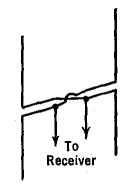The Night Effect
Author: J.B. Hoag
At sunset, at night, and at sunrise, it has been observed that signals from a fixed transmitter appear to come from one which is slowly moving back and forth in a line at right angles to the transmitter-to-receiver direction. This has been found to be due to the presence of the sky-wave, which is particularly strong at night, for frequencies below 500 kHz. It also appears when bearings are taken on an airplane in flight. The student should now read the footnote at the beginning of this chapter. The horizontal component of the electric field will induce voltages in the horizontal arms of the loop, while the vertical component will produce voltages in the vertical arms. The combination of these voltages, added according to their relative strengths and phases, determines the output signal. Obviously, if the ratio of the vertical to the horizontal electric field components changes, the output will change. The ratio will change as an airplane transmitter flies overhead, or as the sky-wave returns from reflection from different places in the ionosphere.
 |
| Fig. 34 L. A simple form of the Adcock antenna |
The Adcock antenna, Fig. 34 L, uses two loops so placed and so phased with respect to each other that the voltages in the horizontal arms cancel each other, while those in the vertical arms do not.
|


 Transmission of Signals
Transmission of Signals  Direction Finders
Direction Finders  The Night Effect
The Night Effect





 Transmission of Signals
Transmission of Signals  Direction Finders
Direction Finders  The Night Effect
The Night Effect

